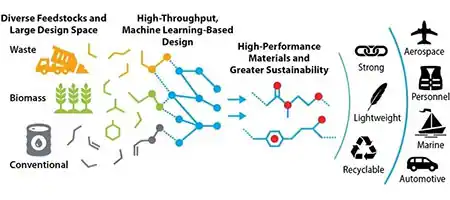Sustainable Polymers Made Easy With PolyID
Chemists have innovated, fusing carbon, hydrogen, oxygen, and nitrogen, crafting plastics for leak-proof food packaging, heat-resistant car parts, and robust personal protective gear. Limitless potential unfolds.
Unlocking the Future of Sustainable Polymers: PolyID and the Path to Performance:
In the ever-evolving landscape of material science, the 21st century presents an intriguing challenge. The goal: Create polymers excelling in performance and sustainability, while reducing reliance on finite petrochemical resources.
The Quest for Sustainable Polymers:
Traditionally, petroleum, a source primarily composed of hydrocarbons, has served as the foundation for polymer creation. These hydrocarbons, although versatile, lack the presence of essential heteroatoms like oxygen and nitrogen. Adding these elements to the polymer matrix demands substantial energy, which might not align with our sustainability aspirations.
Renowned scientist Brandon Knott, hailing from the National Renewable Energy Laboratory (NREL), provides us with a promising solution.
His groundbreaking insight involves the integration of oxygen- and nitrogen-rich biomass and waste materials into the polymer synthesis process.
From corn stalks to algae and even industrial waste, these materials introduce additional chemical linkages. They grant material scientists flexibility in engineering precise polymer properties.
The tool’s details are extensively discussed in the journal Macromolecules.
However, achieving the perfect recipe that strikes an optimal balance between sustainability and peak performance remains a complex puzzle.
PolyID: The AI-Powered Game Changer:
To simplify, NREL introduced PolyID, a cutting-edge tool for Polymer Inverse Design, streamlining this intricate process significantly. This remarkable machine learning platform harnesses the power of artificial intelligence to predict material properties based on molecular structure. It swiftly evaluates millions of polymer designs and generates tailored candidate lists for specific applications.
Deciphering Molecular Structure for Material Properties:
PolyID operates on the principles of “group-contribution theory.” It establishes crucial connections between elemental configurations like oxygen, hydrogen, and carbon. Additionally, it links these configurations to material characteristics such as elasticity, heat resistance, and sealing performance. As it accumulates data on molecular structures and properties, the algorithm improves its ability to predict new polymer attributes.
Nolan Wilson, the lead author at NREL’s Renewable Resources and Enabling Sciences Center, highlights the tool’s potential. Training the algorithm on diverse polymers enhances its ability to forecast novel structures, potentially driving groundbreaking innovations.
Empowering Scientists to Design with Purpose:
PolyID, armed with an extensive library containing thousands of polymers, empowers scientists to approach polymer design from a reverse-engineered perspective. Researchers identify desired properties and select polymer designs that align with these specifications, streamlining the design process.
Case Study: Biodegradable Food Packaging:
In a compelling case study, NREL used PolyID to assess 15,000 plant-based polymers, seeking biodegradable alternatives to food packaging. Manufacturers design these films for high-temperature tolerance and airtight food preservation using high-density polyethylene derived from petroleum.
Using PolyID, the NREL team prioritized key properties while also seeking additional benefits like biodegradability and reduced greenhouse gas emissions. The tool ultimately produced a concise list of seven promising polymer designs, all sourced from biomass.
Subsequent laboratory tests validated PolyID’s predictions. These seven polymers endured high temperatures, reduced greenhouse gas emissions, and extended perishable goods’ shelf life remarkably.
PolyID: The Solution for Tailored Sustainability:
The task of designing sustainable polymers is no small feat, even for seasoned chemists. The growing demand for environmentally friendly products makes solving this issue even more challenging. Enterprises are facing mounting pressure to reduce waste, boost recycling, and lessen their carbon footprint. PolyID emerges as a beacon of hope, skillfully navigating the intricate balance between performance and sustainability.
Nolan Wilson underscores PolyID’s role in aligning environmental and functional needs, ushering in a new era of polymer design.
Conclusion: Paving the Way for Sustainable Innovation:
Finding polymers that combine sustainability and optimal performance is a difficult task in the field of material research. The conventional approach of depending solely on petrochemical resources has its limitations and calls for a new outlook. PolyID, the incredible machine learning tool from the National Renewable Energy Laboratory (NREL), paves a new and exciting path.
Ability Identification:
PolyID, armed with a rich polymer database and predictive molecular structure analysis, revolutionizes polymer design. This cutting-edge tool empowers scientists to craft materials with desired properties, considering sustainability and environmental impact.
We witnessed PolyID’s ability to identify biodegradable alternatives for food packaging films through an engaging case study. This significantly reduced greenhouse gas emissions and extended product shelf life. PolyID is a groundbreaking solution, ensuring top performance while meeting the demand for eco-friendly products.
PolyID, a beacon of hope for eco-friendly alternatives, balances performance and sustainability in our global search for answers. A pivotal stride in merging material science with eco-conscious innovation and productivity, fostering environmental stewardship and progress together. More promising than ever is the future of sustainable polymers, with PolyID setting the standard.
Journal Reference:
Wilson, N, A., et al. (2023). Artificial Intelligence for Discovering Performance-Advantaged and Sustainable Polymers. Macromolecules. doi.org/10.1021/acs.macromol.3c00994
Source: https://www.nrel.gov/

